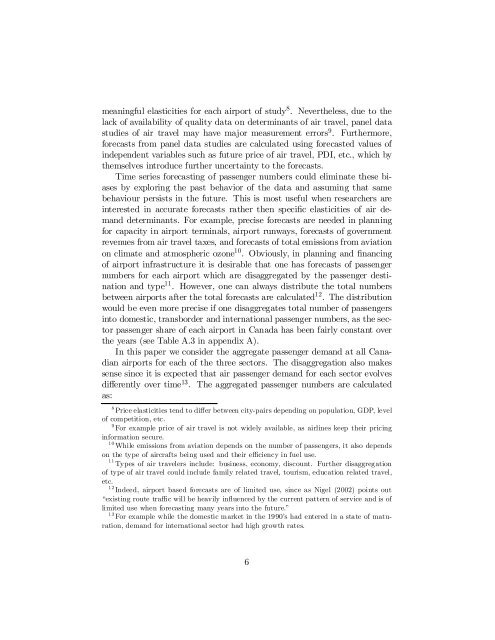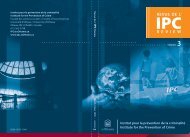0306E - Faculty of Social Sciences - Université d'Ottawa
0306E - Faculty of Social Sciences - Université d'Ottawa
0306E - Faculty of Social Sciences - Université d'Ottawa
Create successful ePaper yourself
Turn your PDF publications into a flip-book with our unique Google optimized e-Paper software.
meaningful elasticities for each airport <strong>of</strong> study 8 . Nevertheless, due to the<br />
lack <strong>of</strong> availability <strong>of</strong> quality data on determinants <strong>of</strong> air travel, panel data<br />
studies <strong>of</strong> air travel may have major measurement errors 9 . Furthermore,<br />
forecasts from panel data studies are calculated using forecasted values <strong>of</strong><br />
independent variables such as future price <strong>of</strong> air travel, PDI, etc., which by<br />
themselves introduce further uncertainty to the forecasts.<br />
Time series forecasting <strong>of</strong> passenger numbers could eliminate these biases<br />
by exploring the past behavior <strong>of</strong> the data and assuming that same<br />
behaviour persists in the future. This is most useful when researchers are<br />
interested in accurate forecasts rather then speci…c elasticities <strong>of</strong> air demand<br />
determinants. For example, precise forecasts are needed in planning<br />
for capacity in airport terminals, airport runways, forecasts <strong>of</strong> government<br />
revenues from air travel taxes, and forecasts <strong>of</strong> total emissions from aviation<br />
on climate and atmospheric ozone 10 . Obviously, in planning and …nancing<br />
<strong>of</strong> airport infrastructure it is desirable that one has forecasts <strong>of</strong> passenger<br />
numbers for each airport which are disaggregated by the passenger destination<br />
and type 11 . However, one can always distribute the total numbers<br />
between airports after the total forecasts are calculated 12 . The distribution<br />
would be even more precise if one disaggregates total number <strong>of</strong> passengers<br />
into domestic, transborder and international passenger numbers, as the sector<br />
passenger share <strong>of</strong> each airport in Canada has been fairly constant over<br />
the years (see Table A.3 in appendix A).<br />
In this paper we consider the aggregate passenger demand at all Canadian<br />
airports for each <strong>of</strong> the three sectors. The disaggregation also makes<br />
sense since it is expected that air passenger demand for each sector evolves<br />
di¤erently over time 13 . The aggregated passenger numbers are calculated<br />
as:<br />
8 Price elasticities tend to di¤er between city-pairs depending on population, GDP, level<br />
<strong>of</strong> competition, etc.<br />
9 For example price <strong>of</strong> air travel is not widely available, as airlines keep their pricing<br />
information secure.<br />
10 While emissions from aviation depends on the number <strong>of</strong> passengers, it also depends<br />
on the type <strong>of</strong> aircrafts being used and their e¢ciency in fuel use.<br />
11 Types <strong>of</strong> air travelers include: business, economy, discount. Further disaggregation<br />
<strong>of</strong> type <strong>of</strong> air travel could include family related travel, tourism, education related travel,<br />
etc.<br />
12 Indeed, airport based forecasts are <strong>of</strong> limited use, since as Nigel (2002) points out<br />
“existing route tra¢c will be heavily in‡uenced by the current pattern <strong>of</strong> service and is <strong>of</strong><br />
limited use when forecasting many years into the future.”<br />
13 For example while the domestic market in the 1990’s had entered in a state <strong>of</strong> maturation,<br />
demand for international sector had high growth rates.<br />
6
















